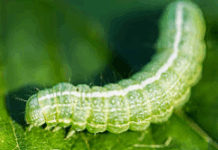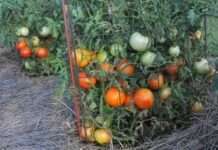When I was a kid my favorite thing to eat from our garden were melons. Watermelon, Cantaloupe and honeydew were the common ones we grew. Melons are tender, warm-weather vegetables that require culture similar to other vine crops. There are many different types of melons, most of which perform well in Kansas. Most melons are large-vined plants, although there are some newer, more compact varieties.
• Muskmelon and cantaloupe. Despite common usage, muskmelons and cantaloupe are two slightly different types of melon. The vast majority of what are commonly called cantaloupes are musk melons. These are orange- or green-fleshed melons that have netted skin. They also “slip” from the vine when ripe, as discussed below under harvesting. True cantaloupes do not have netting on the rinds and are not very common in the United States.
• Winter melon. Other melons such as honeydew, Crenshaw, and casaba are considered winter melons. They have smooth rinds, minimal odor, and do not “slip” from the vine like muskmelons.
• Oriental melon. This type of melon, sometimes called Korean melon, has become more common in the United States in local farmers markets, although it is still fairly uncommon. These melons typically have yellow skin and white, crunchy flesh with a mildly sweet, sometimes floral taste. These are the earliest maturing melons.
Variety considerations. There are many types of melons and melon varieties available. For home gardeners, considerations such as desired fruit size and desired vine size will often take precedence over other factors. Disease resistance, especially powdery mildew resistance, will be helpful for many gardens. Newer hybrid varieties will typically have smaller seed cavities and higher sugar levels, while heirloom varieties may have much larger seed cavities. Many newer varieties will have a longer window of high eating quality around the ideal harvest window, while older varieties may not be as good if picked too early or too late.
When to plant. Melons are injured by light freezes; all danger of frost should be past before planting seeds or setting plants. Consistent soil temperatures of at least 60°F are necessary to encourage good germination, and warmer soil temperatures will speed up germination. Early to mid-May is a standard planting date throughout most of Kansas, but planting can be done later as well, allowing about 100 days until the expected first frost date. Melons can be transplanted, but this is a challenge in windy conditions due to the very fragile stems.
Spacing. Cantaloupe vines spread 6 to 8 feet wide, so row spacings of 6 feet are necessary, with individual plants spaced every 18 inches to 2 feet in the row. Types with compact vines may be able to grow in a 2-by-2- or 3-by-3 foot space. Many melons can be successfully grown on a trellis, with one to two plants per trellis.
Crop rotation. If possible in your garden space, do not plant melons in the same area where cucumbers, melons, squashes, or pumpkins have been planted in the past 3 to 4 years.
Care. Melons usually do not require heavily fertilized soil. Normal maintenance fertilizers should produce an adequate crop. Mulching with black plastic warms soil, improves early season growth, and makes weed control easier. Row covers may be useful to reduce cucumber beetle damage in the early season but must be removed once the plants start flowering. Row covers can also help increase the success of transplanting due to protection from the wind.
Melons produce separate male and female flowers and require bees to pollinate them. Male flowers are more abundant and are present 1 to 2 weeks before female flowers begin to develop. Melons need plenty of water during early growth, flowering, and early fruit development.
Once the melons have reached full size but have yet to ripen, watering should be minimized to encourage sweet, flavorful fruit with high sugar content.
Harvesting. Muskmelons are ready for harvest when the stem slips easily and cleanly away from the end of the melon, leaving a clean dish-shaped scar. They should be slightly soft and have a pleasant aroma. Honeydew melons typically turn a creamy color rather than have a green cast when ripe, and may develop a more waxy texture to the rind. They do not slip. Casaba, Crenshaw, and Oriental melons do not slip from the vine but do develop a yellow rind color and exhibit a slight softening at the flower end opposite the stem. Melons will not ripen off the vine, although they may improve in flavor somewhat if left at room temperature for a few days.





